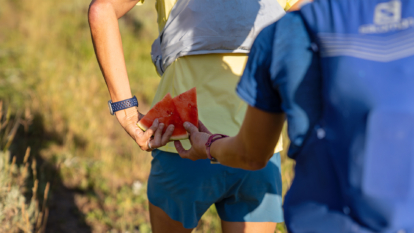Keeping Pace
One runner gets her fix helping others chase their dreams, again and again.
Listen to the story
All photos by Brendan Davis
Tom’s body had been seizing up for hours when he first went down. He was around 85 miles into the 2001 Western States 100-mile endurance run; I’d been running with him for about the last 20. After more than 24 hours on the trail, his muscles had tightened up so much that he listed to the left. Every time he hit a rock, root or rut that challenged his footing, his balance would falter. He’d fall over. I’d pick him up and pull on his right arm, tugging it downward toward the ground to straighten him out. On we’d go.
A mutual friend had connected us. Tom needed a pacer: someone to run with him for a portion of the race, to keep him eating, drinking and moving efficiently, and to distract him with good company and bad jokes. I needed long mileage days to train for a multi-day adventure race later that summer. The fact that we were 34 years apart—I was 29 and Tom was 64—and we barely knew each other was irrelevant.
I waited for Tom at the mile 62 Foresthill aid station, worried that my nagging patellar tendonitis would get in Tom’s way, that it would slow us down or force me to bail before I could hand him off to the next pacer. But as we kicked up brown dust in the night, my pain, and the awkwardness of being new running partners, quickly dissipated.
The longer Tom and I ran, the less I felt my own body. My knee pain was gone. I was wholly focused on my job, having Tom run straight through aid stations while I refilled his water bottles, grabbed some snacks and caught back up with him. Dangerously close to missing the cutoffs, he couldn’t afford to graze. I calculated times in my head, did math while we ran and encouraged him to shuffle a little faster to get to the next aid station so they wouldn’t pull him from the course. This was his third try at Western States, and I could feel how badly he wanted to finish. If I could have given him the left side of my body, I would have.
We both cried when he missed the race cutoff at mile 94. But on the flight home, I’m sure I grinned as I rested my head against the window. I’d found a new way to experience the sport I loved. I vowed to play the role again.
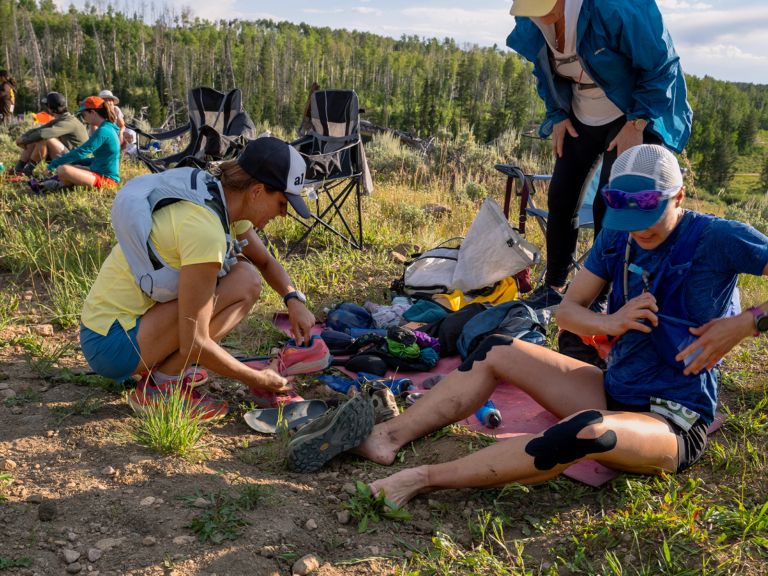
Runners enter trail races as individuals, but they finish them as a team. While Markovich (right) swaps empty bottles for full ones, Jhung (left) swaps out her shoes and Markovich’s mother (top) takes snack orders.
My next opportunity came three summers later. I’d be pacing for my new friend Darcy, who intimidated me though not on purpose. We met when she kicked my ass at a winter adventure race. I had subsequently moved to her hometown of Boulder, Colorado. We’d run together a few times since then, but I was certain these afternoon jaunts were her second outing of the day.
She picked me up at mile 76 of the Leadville 100, sometime after dark. She was in third place. I’d be pacing her all the way into the finish and nervously hoped I’d be able to keep up. Every time we’d leave an aid station I’d stress: Did I fill her hydration enough? Did she have enough food? Did I correctly calculate the number of miles before the next refill station?
“Can I have my gloves?” she asked when the high mountain air turned freezing in the night. Without breaking stride, I slung around her pack that I’d been carrying and dug through the gear stashed inside. Found one glove. Phew. Handed it to her. After fumbling around for what seemed like forever—I was a bumbling new employee—I found the other and helped her put it on.
We ran the perimeter of Turquoise Lake, catching glimpses of moonlight glistening on the water through tall pines. I ran in front, leading the way into the night. As we began the 3.5-mile climb into town, I heard the sounds of a generator off in the distance: the finish line. Turning around to check on Darcy, I saw two headlamps behind us. I was certain I heard female voices.
“I think we’re being chased,” I told her. She didn’t respond.
I looked back again. Then again.
“You gotta stop doing that,” she said. I was annoying her. But I decided that if I were her, I’d want me to be annoying. I’d deal with the consequences later.
I kept checking back, kept pushing the pace. She likely didn’t need me to do this. But I did, and she held.
After the race, there was a chunk of time where I wasn’t sure if she’d ask me to go on runs with her in the afternoons anymore. I wondered if I’d need to find some other new people in town. That maybe I’d blown it as a friend, though I was sure I’d nailed it as a pacer. As it turned out, time and miles were all we needed to solidify what would become a deep bond.
I don’t believe in karma. I wasn’t pacing Tom or Darcy to have the favor returned another time. I may have been giving them fuel, emotional support, a backside to follow or a lit path from my headlamp behind them, but what I was getting in return was far greater: friendship, community, a sense of purpose, an opportunity to step outside myself and be a part of something bigger. It was impossible not to be moved—and impossible not to want to do it again.
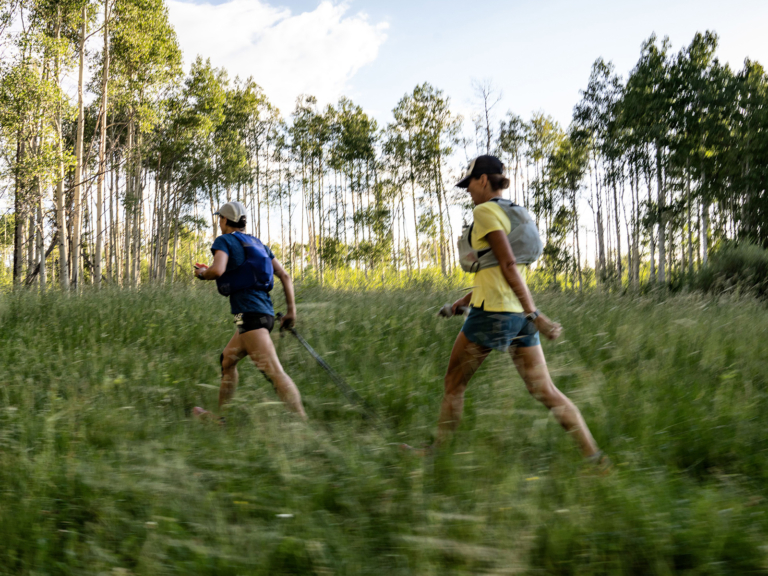
With a good pacer on hand, the miles can often fly by. Jhung and Markovich slide into the groove at the Never Summer 100K.
A couple of years ago, I was back in Leadville for another 14-mile pacing job, this time for my friend and neighbor Brad. His family and I worried about him as night descended across the high-mountain valley of Twin Lakes, mile 62 of the 100-mile course. It was 9 p.m., and Brad had been running for 19 hours. We knew he was somewhere between the 12,600-foot summit of Hope Pass that loomed miles above us, and the campground parking lot where we mulled about nervously, waiting.
Much had happened in the years since I’d last been at Leadville. For starters, a pandemic had set in. Just before that, my father and mother had passed away within three months of each other. As I’d struggled with grief and the overwhelming task of sorting affairs, a wise friend told me to do something nice for someone else. “Sometimes that can make you feel better about your own situation,” they said. I did, and it did.
Pacing, I realized, made me feel good. By this point in my life—raising two kids but still craving adventure, both parents gone and left with an ache that can be hard to fill—the kind of community I found as part of Brad’s team was exactly what I needed. I felt whole, balanced and useful. Almost 20 years after pacing Darcy at this very race, I had come to realize that helping someone else achieve their goals could be more rewarding than achieving my own.
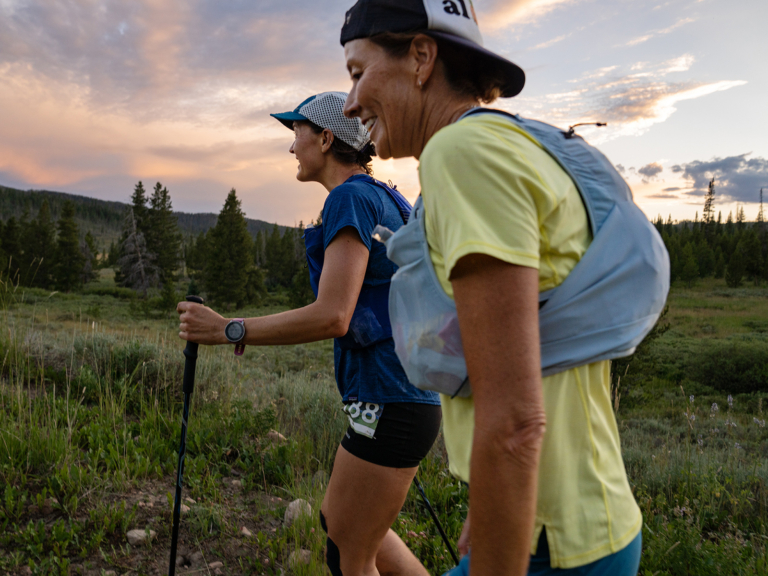
Sometimes, a pacer’s job is to run in front or from behind. Other times, it’s to power hike side by side and keep the conversation flowing.
When a bobbing headlamp illuminated his sweaty face at 9:30 p.m., we guided Brad into the crew pit we’d set up—a camp chair, cooler, stove and plastic bins full of meticulously organized fuel and gear. We sat him down. Changed his socks. Fed him ramen. Minutes before 10 p.m., the cutoff for leaving Twin Lakes, he rose and ran to the cheers and cowbells of the assembled crowd.
For the first 62 miles of this 100-mile race, Brad had run alone. Now he had me. I took his pack and threw it over my own. Back in a familiar role, I assessed how he was moving as we clamored up a short, steep climb and onto the singletrack of the Colorado Trail. A full moon danced above aspen leaves, lighting an otherwise inky, near-midnight sky. We shuffled along into the darkness, our steps a rhythmic background soundtrack to the tales Brad shared from his race up until this point. We settled in as partners.
I took my job seriously. Every 45 minutes, I’d firmly but kindly hand him a gel packet that I’d opened with my teeth, make sure he finished it, then take the trash from him. Every 30 minutes, I’d give him a salt tab and a drag from my hydration hose or his soft flask to wash it down. When I sipped my own water, I made sure he took some long sips of his own. Shuffle the downhills and flats; power hike the ups. Encourage him. Stay positive. Be good company. Fourteen miles and five hours later, around 3 a.m., I handed Brad off to his next pacer. We’d made up 45 minutes. I fell asleep content.
Because ultramarathons are ridiculously hard, Brad unfortunately dropped out a few miles from the finish that year. But the following August, he was back. And so was I.
We waited again at Twin Lakes. I spent the day in my two-person tent: read, ate, napped, wrote and napped some more, despite it being the middle of the day and very loud. Amid the busy scene—every runner’s support crew and pacers, dogs, generators and announcers—I cocooned.
I’d gotten good at compartmentalizing. The last few years my parents were alive, they’d lived in a memory-care facility in San Diego, California. I’d be all-in when I was with them, then jump in the ocean and have a burrito and a beer to recover from the emotional mess. Back home in Boulder, I’d attempt to put it all out of my mind.
That entire day leading up to pacing Brad, I conserved my energy and rested up—focused on myself. When it was go-time, I put on my headlamp, grabbed some extra snacks from the aid station for both of us and caught up to him at the top of the same steep hill we’d started on together the year before.
Fourteen miles later, at 2 a.m., I passed him off to his next pacer—Darcy. Six or so hours after that, we all screamed with joy when we saw Brad cresting toward the finish line.
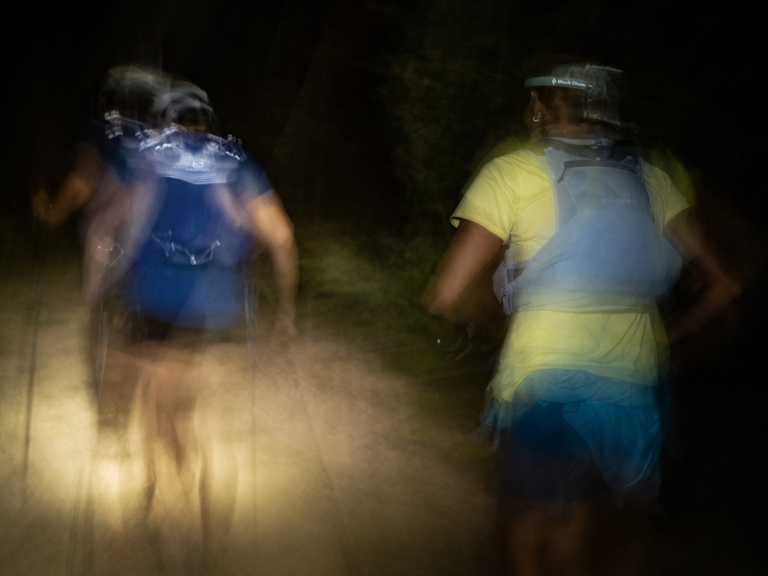
No sun? No problem—especially when you have a pacer to keep you energized as you face down dark hours on the trail. Jhung and Markovich cruise from day to night.
